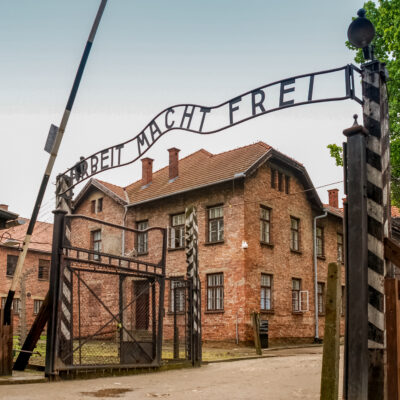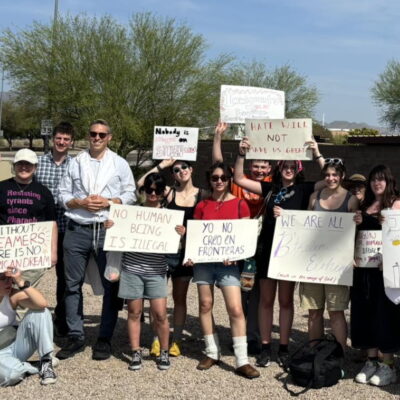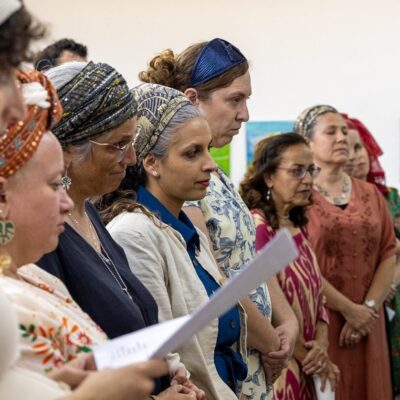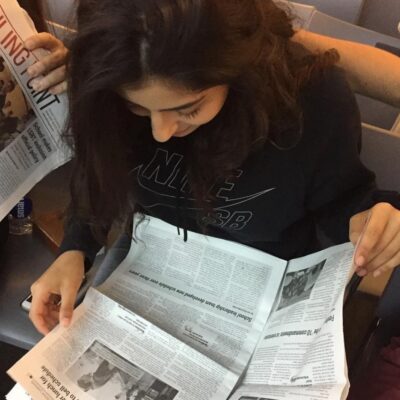Strategic Directions for Jewish Life: A Call to Action
Marking the 2nd anniversary of the release of the 2013 Pew Research Center’s Portrait of Jewish Americans, a highly diverse group of thought leaders from all around the United States has framed a “Statement on Jewish Vitality,” advocating strategic responses to respond to the challenges to the Jewish future.

American Jewry now stands at a crossroads. Our choices are stark: we either accept as inevitable the declining numbers of engaged Jews, or we work to expand the community and improve the quality of Jewish life going forward.
Despite the evidence of deeply disturbing population trends, the community is bereft of any sense of crisis.
This posture stands in stark contrast to what happened in the 1990’s when communal organizations acknowledged a Jewish continuity crisis and created elaborate task forces and special programs to address it. These include effective programs, such as Birthright Israel and leadership training efforts. Today’s near-inaction bespeaks a self-imposed helplessness. The time to mobilize the Jewish community to adopt effective policies and programs is now.
The Challenging Context
Let us recall the most salient findings of the Pew Research Center’s “Portrait of Jewish Americans”:
- Late marriage and non-marriage: most (51%) non-Orthodox Jews aged 25-39 are not married, and of those aged 40-49, fully 18% have never married.
- Frequent intermarriage: Of those raised Reform – to take one example – 80% of those who married between 2000 and 2013 have non-Jewish spouses.
- Low birthrates: Non-Orthodox Jewish women bear, on average, just 1.7 children, below the 2.1 replacement level; and owing to intermarriage, many of those children will identify as non-Jews when they grow up.
- The disaffiliation of two million Jews: Of the 7.2 million adult Americans who have at least one Jewish parent, 5.1 million identify as Jews and the other 2.1 million do not.
- Overall, we find diminished Jewish social connections, a weaker sense of meaningful and compelling Judaism, and fewer engaged Jews, outside the Orthodox sector. Down the line, we face the prospect of a community consisting of many ultra-Orthodox Jews, on the one hand, and “partly Jewish” Jews, as they call themselves, on the other.
Strategic Ideas
In light of these deeply unsettling trends, we call for: A communal mobilization campaign aimed at policy makers and philanthropists, conveying two messages:
- The decline of the Jewish “Middle” must be recognized: We are seeing severe declines in the “Jewish Middle” – Jewishly engaged individuals and communities outside of Haredi Orthodoxy.
- Effective responses are feasible: We can significantly influence the size, character, commitment and Judaic capacity of this Jewish Middle.
To put this another way, if current trends continue unchecked, the American Jewish community will grow smaller and less vital.
But there’s something we can do about it.
Research demonstrates that several communal endeavors that can counteract the alarming trends. The most effective share three critical features:
- They build Jewish social networks.
- They convey Jewish content.
- They target peer groups of Jews at crucial stages of life.
The most promising approach focuses on adolescent Jewish education … day schools, supplementary schools, overnight Jewish camps, Israel trips, and youth groups. These experiences, taking place in the crucial identity-forming high school years, work in synergy. They support one another, and recruit for one another.
Actions can be taken to expand participation in each of these settings:
- Several states have adopted tax policies that offset day school tuition. The Jewish community should support such efforts and find other ways to make day schools more affordable.
- While supplementary schools (usually congregationally sponsored) exert a limited impact in the pre-Bar/Bat Mitzvah years – there are important exceptions. Supplementary schooling lasting 7 or more years (well into the teen years) produces measurable, lasting effects, independent of other educational experiences. In fact, one value of supplementary schooling is that it serves as a critical recruiting ground for camps, Israel trips, and youth groups. The combination of supplementary education with these other adolescent programs enhances the chances of securing Jewish continuity.
- Jewish summer camp enrollment is now bumping up against capacity, and camp costs strain many family budgets. Yet, $1 million is sufficient to initiate an overnight camp on rented property that would serve 500 campers per summer on a self-supporting and sustainable basis.
- We have expanded Israel travel via Birthright. Why not provide the same support for Israel trips for teenagers, especially in light of recent research demonstrating the effectiveness of such trips, and the challenges that these teenagers will soon face on the college campus?
- Two well-funded youth groups (NCSY and BBYO) have enjoyed considerable success. What about extending philanthropic support to other major youth groups so that the vast pool of Jewish teens can be identified and organized?
- Congregations – and specifically their rabbis, educators, and youth professionals – play a critical role in recruiting and sustaining teenagers’ participation in all these educational experiences, to say nothing of the fact that they already provide a minority with opportunities for prayer, learning, service, and social experiences. Congregational leaders should give greater attention to, and raise the priority and quality of, adolescent Jewish education.
After the high school years, organized Jewish campus activities, such as those sponsored by Hillel, Chabad and other campus-oriented agencies produce positive outcomes for those whom they engage. Certainly, the number of on-campus Jewish professionals engaged in campus outreach has expanded in recent years. That said, non-Orthodox rabbis and trained Jewish educators on the campus are still few and far between. Clearly, we need additional on-campus rabbis and educators with pluralistic orientations.
Beyond the campus, the largely single, urban, young adult population displays little interest in affiliating with synagogues and other mainstream Jewish institutions. However, some do participate in less conventional Jewish venues either episodically or on a more sustained basis. Of particular appeal to the post-college set are Moishe Houses, Jewish and Israeli film festivals, concerts, and, for the more educated and engaged, independent minyanim and such Jewish learning experiences as Limmud. All could be expanded.
While all of these investments should help raise affiliation and increase the in-marriage rate, a large number of Jews will continue to intermarry. But we must bear in mind that intermarriages can be transformed to in-marriages by the act of conversion. Several existing conversion initiatives already produce a relatively large number of converts at relatively little cost. More conversion-oriented courses and institutes will raise the conversion rate further, producing more in-marriages with all the positive consequences for the Jewish future
These proven measures certainly will strengthen Jewish engagement and commitment. The success of PJ Library in reaching 165,000 families monthly speaks to the possibilities of new ways to reach Jewish families, young and old. Other ideas hold great promise as well. These include a retreat experience, perhaps in the form of a communal gift of a retreat to all young couples, or to new parents.
But beyond all of the ideas mentioned above, we face a task of a different order. Over the last 50 years, a massive public-health education effort – encompassing nutrition, exercise, education about the evils of tobacco – has extended the life expectancy of all people, particularly the well-educated. Similarly, the Jewish community can teach concerned Jewish grandparents and parents how to improve the lives of their family members and make their progeny stronger, more engaged Jews. “Jewish Public Health Education” can underscore the value of day schools, education through the high school years, Jewish camps, Israel trips, youth groups, and attending universities with strong Jewish campus communities.
The Birthright experience offers two important lessons. One is that educational interventions influence Jewish engagement outcomes in general, and inmarriage rates in particular. Second, Birthright makes clear that major transformative projects can be mounted, and that they do make a difference.
Moving Forward
In brief, we need to advance on multiple fronts in the coming years. The American Jewish community needs:
- A communal mobilization campaign
- Diminished costs for day school tuition
- More emphasis upon quality supplemental schooling that extends at least seven years
- Major investment in low-cost Jewish summer camps
- Thousands of Jewish teenagers traveling to Israel
- Significant expansion of Jewish youth groups
- Congregations prioritizing their teenagers
- More outreach-oriented and pluralist rabbis, both on and off campus
- Jewish cultural events, prayer communities, and learning activities among Jewish young adults
- Retreat experiences for young couples and families
- Jewish Public Health Education aimed at parents and grandparents
- Continue and expand Birthright Israel’s numbers
We believe these steps are not only urgently necessary for a healthier Jewish future, but are also achievable in our time.
Signatories
Institutional affiliation is for identification purposes only. Signatories are signing in a strictly personal capacity.
Rabbi B. Elka Abrahamson, President, The Wexner Foundation
Karen Adler, Board member, several national Jewish organizations, New York
Mimi Alperin, Vice-Chairman, Board of Trustees, Jewish Theological Seminary
Rabbi Sharon Cohen Anisfeld, Dean, Rabbinical School of Hebrew College, Boston, MA
Dr. Steven Bayme, Visiting Faculty, Yeshivat Chovevei Torah
Mem Bernstein, Chairman, AVI CHAI Foundation
Rabbi Peter S. Berg, Senior Rabbi, The Temple, Atlanta, Georgia
Mijal Bitton, Doctoral Candidate, NYU & Wexner Graduate Fellow
Dan Brown, founder, eJewish Philanthropy
Dr. Erica Brown, author and educator, Washington, D.C.
Rabbi Sharon Brous, Founding Rabbi, IKAR, Los Angeles, California
Rabbi Scott Bolton, Congregation Or Zarua, NYC
Dr. David Bryfman, Chief Innovation Officer, Jewish Education Project
Rabbi Angela Warnick Buchdahl, Senior Rabbi, Central Synagogue, New York
Prof. Steven M. Cohen, Hebrew Union College-Jewish Institute of Religion
Rabbi Elliot Cosgrove, Rabbi, Park Avenue Synagogue
Rabbi Rachel Cowan, New York
Rabbi Eric Cytryn, Rabbi, Beth El Temple, Harrisburg, Pennsylvania
Barbara Dobkin, past Chair, American Jewish World Service
Rabbi Stephen J. Einstein, Founding Rabbi Emeritus, Cong. B’nai Tzedek, Fountain Valley, CA
Rabbi Ed Feinstein, Rabbi, Valley Beth Shalom, Encino, California
Prof. Sylvia Barack Fishman, Joseph and Esther Foster Professor of Contemporary Jewish Life, Brandeis University
Rabbi David Frank, Rabbi, Temple Solel, Cardiff, California
Michelle Friedman MD, Chair of Pastoral Counseling, YCT Rabbinical School
Rabbi Laura Geller, Senior Rabbi, Temple Emanuel of Beverly Hills, Beverly Hills, California
Rabbi William G. Gershon, Rabbi, Congregation Shearith Israel, Dallas, Texas
Rabbi Arnie Gluck, Rabbi, Temple Beth-El, Hillsborough, New Jersey
Rabbi Neal Gold, Rabbi, Temple Shir Tikva, Wayland, Massachusetts
Prof. Lisa Grant, Hebrew Union College-Jewish Institute of Religion
Harold Grinspoon, Grinspoon Foundation, Springfield, Massachusetts
Rabbi Irving (Yitz) Greenberg, Founding President, Jewish Life Network, Steinhardt Foundation
Prof. Harriet Hartman, Editor-in-chief, Contemporary Jewry; Professor of Sociology, Rowan University
Prof. Samuel C. Heilman, Harold Proshansky Chair in Jewish Studies, CUNY Graduate Center and Distinguished Professor of Sociology, Queens College
Roger Hertog, Hertog Foundation
Rabbi David Hoffman, Vice-Chancellor and Chief Advancement Officer, Jewish Theological Seminary
Rabbi Sarit Horwitz, BJ Rabbinic Fellow, Cong. B’nai Jeshurun, NY & Wexner Grad. Fellow
Rabbi Howard Jaffe, Rabbi, Temple Isaiah, Lexington, Massachusetts
Rabbi Jeremy Kalmanofsky, Rabbi, Congregation Ansche Chesed, New York
Rabbi Elana Kanter, The Women’s Jewish Learning Center, Phoenix, Arizona
Aliza Kline, Founding Executive Director, OneTable
Lynn Korda Kroll, New York
Rabbi Noa Kushner, The Kitchen, San Francisco, California
Rabbi Steve Kushner, Rabbi, Temple Ner Tamid, Bloomfield, New Jersey
Robert I. Lappin, President, Lappin Foundation, Salem, Massachusetts
Rabbi Marion Lev-Cohen, Central Synagogue, New York
Dr. Adriane Leveen, Hebrew Union College-Jewish Institute of Religion
Prof. Jon Levisohn, Jack, Joseph & Morton Mandel Chair in Jewish Educational Thought, Brandeis University
Rabbi Cliff Librach, Senior Rabbi, United Jewish Center, Danbury, Connecticut
Prof. Deborah Lipstadt, Dorot Professor of Modern Jewish and Holocaust Studies, Emory University, Atlanta, Georgia
Rabbi Bennett Miller, Rabbi, Anshe Emeth Memorial Temple, New Brunswick, New Jersey
Rabbi Leon Morris, Vice President for Programs in Israel, Shalom Hartman Institute
Rabbi Danny Nevins, Pearl Resnick Dean of The Rabbinical School, JTS
Letty Cottin Pogrebin, Author and activist
Prof. Riv-Ellen Prell, Prof. of American Studies and Director, Ctr. for Jewish Studies, Univ. of Minnesota
Rabbi Richard S. Rheins, Senior Rabbi, Temple Sinai, Denver, Colorado
Rabbi Peter Rubinstein, Dir. of Jewish Community and Bronfman Ctr. for Jewish Life, 92nd Street Y
Rabbi Jeffrey K. Salkin, Senior Rabbi, Temple Solel, Hollywood, Florida
Prof. Jonathan D. Sarna, Joseph H. & Belle R. Braun Professor of American Jewish History, Brandeis University.
Rabbi Julie Schonfeld, Executive Vice President, Rabbinical Assembly
Dr. Bernard Shapiro, Principal Emeritus, McGill University, Montreal, Canada
Michelle Shain, Ph.D. candidate, Heller School for Social Policy & Management, Brandeis University
Rabbi Michael Siegel, Norman Asher Rabbinic Chair, The Anshe Emet Synagogue, Chicago
Rabbi Alan Silverstein, Rabbi, Congregation Agudath Israel, Caldwell, New Jersey
Rabbi Gerald Skolnik, Rabbi, Forest Hills Jewish Center
Dr. Erin Leib Smokler, Director of Spiritual Development, Yeshivat Maharat
Rabbi Daniel Smokler, Chief Innovation Officer, Hillel International
Jonathan S. Tobin, Senior Online Editor, Commentary Magazine
Diane Troderman, past chair of JESNA (Jewish Education Service of North America)
Rabbi Steven C. Wernick, Chief Executive Officer, United Synagogue of Conservative Judaism
Prof. Jack Wertheimer, Professor of American Jewish History, Jewish Theological Seminary
Rabbi Ethan Witkovsky, Rabbi, Park Avenue Synagogue, New York
Rabbi David Wolpe, Rabbi, Sinai Temple, Los Angeles, California
Rabbi Irwin Zeplowitz, Rabbi, The Community Synagogue, Port Washington, New York
Rabbi Sheldon Zimmerman, Rabbi, The Jewish Center of the Hamptons, East Hampton, NY













